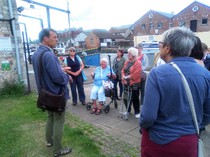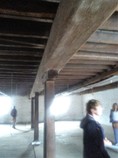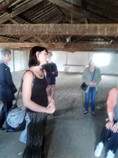
VISIT TO THE MARITIME MUSEUM
14 JULY 2016
At the canal basin Malcolm explained the history of the railway carrying goods from the quay for distribution around the country and in return bringing goods to the quay for shipment around the world – all of course via the warehouses. He pointed out the remains of the rail turntable (allowing wagons to be turned) with both broad and standard gauge rail lines.
Many members remembered the Maritime Museum’s eclectic collection of boats from all over the world, many of which were restored in the old electricity building (now the Quay Climbing Centre) before being displayed in the building and in the basin.
Kelly Johnson, the Bike Shed’s Director of Strategy and Communication, led us to the side of the first of the three buildings planned for refurbishment. She pointed out the traces of a structure once attached to the building which they intended to reinstate, mainly in glass, providing an attractive café and main entrance to the building.
She introduced us to Dominic Acland, their Heritage Consultant, who talked about how busy the canal had been importing goods from all over the world and shipping out the wool. The quay was the key to Exeter’s wealth and in 1839, when these warehouses were built, Exeter was at its peak. But in 1844 the railway came to Exeter: Dominic wondered how no one foresaw what damage that would soon do to the shipping business.
He explained that they are currently negotiating with various fund-raising authorities over the projected improvements to the building and that they have a 2-year window to negotiate the plans and were then expecting a 25-year lease.
Kelly then outlined the Bike Shed’s commitment to celebrating the best of Exeter and their focus on promoting work by local people, whether ceramicists or web designers or anything in between. They also plan to bring artists from across the world both to work here and to display their creations.
She said this is not to be a closed building open to a select few but instead should connect with everyone in the city with such incitements as a ground floor market selling fine handicraft and art and other activities such as cycle hire and perhaps a bakery.
There would certainly be a childrens’ play area and also an area with recordings by actors of people’s memories and of the diaries of those who worked in the warehouses.
Kelly explained that they will be taking over all three adjacent buildings. The ground floors are currently in use but the upper floors are empty. We entered the Grade II building through a door (on the left in this photo of the three buildings) which led directly upstairs to the 1st floor where we found ourselves in a very spacious area planned to be a 250-seat performance space.
We went through to the second building’s 1st floor, to be used for music and comedy. It has good lighting and will have a lift and balconies overlooking the basin. The adjoining floor space in the third building is to be an area for start-up companies and entrepreneurs.
As part of an overall endeavour to connect the business and arts communities it is felt important to provide, with hot desk measures, spaces for small businesses enabling them to avoid the burden of long term high rents.
There will also be space for artists’ studios where they can create work which could then be sold in the market downstairs and on the top floor are to be rehearsal studios. A beautiful space with magnificent beams which might, however, create a problem for stage props as there is limited clearance. We admired here an exceptionally long beam made from a single tree – who needs steel!
Kelly explained that the plan is to offer pop-up events in the building over the next year until it is closed for 18 months for its extensive remodelling. It is also their hope to organise a 3-month “festival” next summer. This would be in a tented area on the grass where the café is planned for local communities to book space for anything from 10 minutes to 3 days. Everything will be considered – from art gallery to yoga – all to be curated by the local community.
This was a fascinating trip round a fascinating building. Many comments and ideas were offered by the group to the management who are so very keen to incorporate the thoughts and memories of the total community into their plans for this wonderful space. We wish them every success with their great efforts.
.



